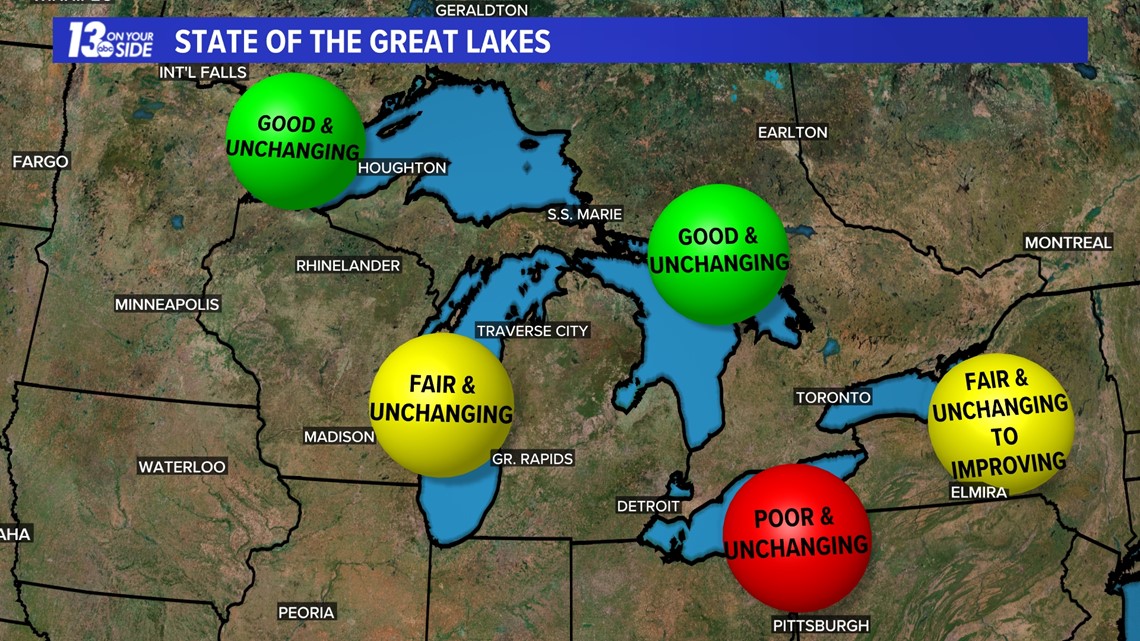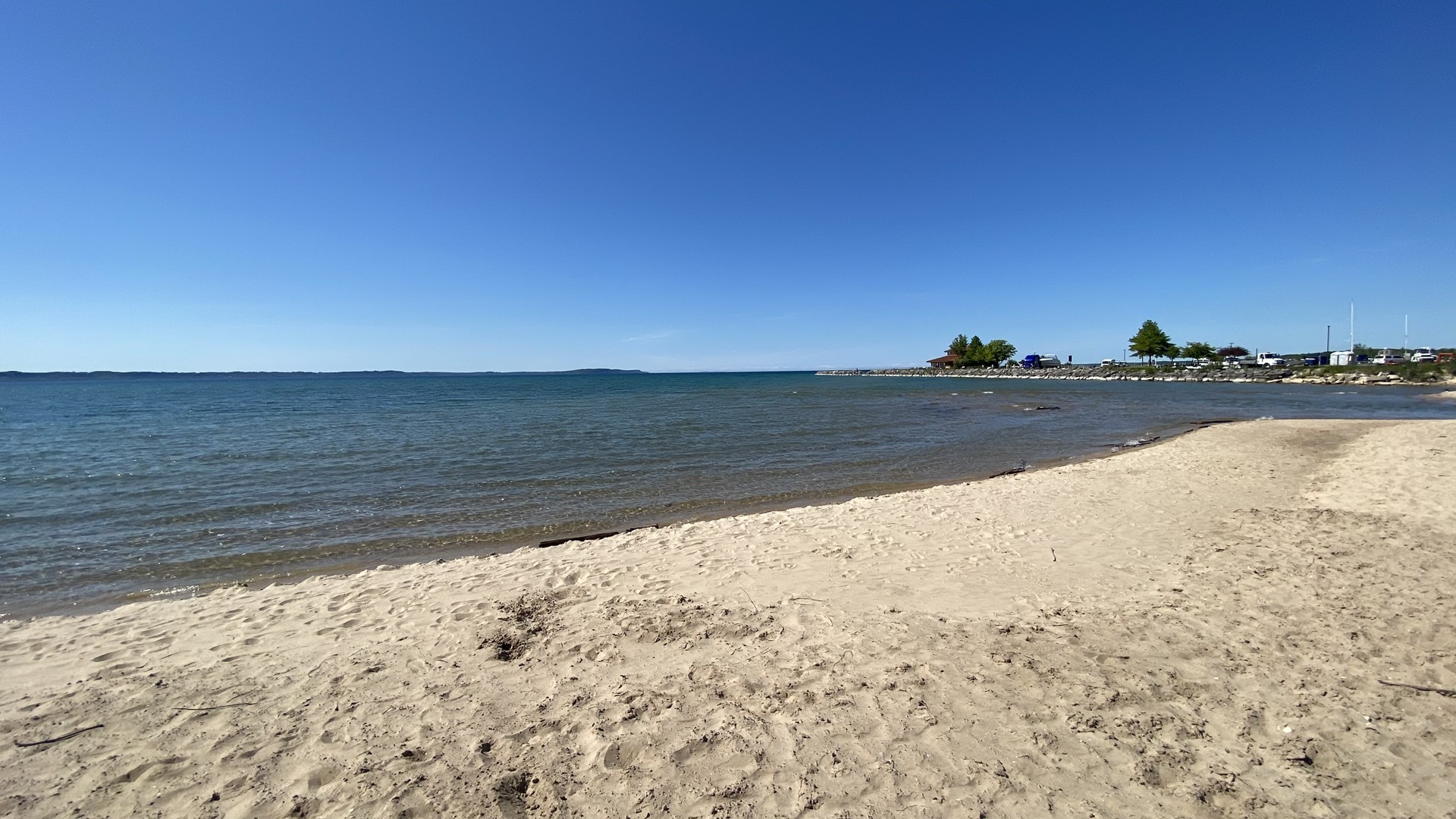MICHIGAN, USA — An international analysis shows tremendous progress has been made to restore and protect the Great Lakes ecosystem, but challenges remain that could become detrimental if not tackled in the future.
The triennial analysis between the United States and Canada was included in part of the Michigan Department of Environment, Great Lakes and Energy’s (EGLE) annual State of the Great Lakes report, which was released in December.
The analysis, which highlights the status and trends of Great Lakes ecosystem health, is conducted once every three years as part of the Great Lakes Water Quality Agreement (GLWQA) between the two countries.
ECOSYSTEM MEASURES & GRADES
The status of the Great Lakes is graded on three levels – good, fair and poor. The trends of the Great Lakes also graded on three levels – improving, unchanging and deteriorating.
To determine these grades, the report considers nine measures of ecosystem health:
- Can we drink the water?
- Can we swim at the beaches?
- Can we eat the fish?
- Have levels of toxic chemicals declined in the environment?
- Are the lakes supporting healthy wetlands and populations of native species?
- Are nutrients in the lakes at acceptable levels?
- Are we limiting new introductions and the impacts of non-native species?
- Is groundwater negatively affecting the water quality of the lakes?
- Are land use changes or other stressors impacting the lakes?
Broadly, the Great Lakes are assessed as “fair and unchanging.” Progress to restore and protect the Great Lakes have been noted, including the reduction of toxic chemicals and a reduction in the establishment of new non-native aquatic species. Challenges, however, such as the impacts of nutrients, invasive species and climate change are aggravating ongoing threats to the ecosystem.
The status and trends are analyzed on a closer scale lake by lake.


Lake Superior and Lake Huron are considered “good and unchanging” for their respective ecosystems, the highest available grade. Lake Michigan was rated “fair and unchanging”; Lake Huron is considered “fair and unchanging to improving”; and Lake Erie’s ecosystem is considered “poor.”
The analysis noted Lake Superior’s forested watershed and coastal wetlands help maintain water quality and a healthy aquatic ecosystem.
Lake Huron was upgraded from “fair” in 2019 – the only individual lake upgraded from the last analysis – because of it continuing to be a good source of high-quality drinking water and a declining trend of toxic chemicals. Issues remain, including nearshore algal blooms and a reduction in offshore nutrients by invasive filter-feeding mussels.
Lake Michigan was analyzed as an ecosystem that supports a diverse array of plant and animal species. Its waters continue to provide opportunities for swimming and recreation use. Invasive species and other stressors continue to affect both water quality and the lake’s food web.
Improvement has been noted across Lake Ontario, with fewer beach closings and declines in contaminant concentrations in fish.
Lake Erie was the lone “poor” rating, with no signal of improvement soon. The analysis noted continued algal blooms and elevated nutrient concentrations as persistent problems. Positives include the lake continues to be a good source of high-quality drinking water and supports the largest self-sustaining Walleye population in the world.
Further detail on the ecosystem of each individual Great Lake can be found here.
IMPROVEMENT FOR THE FUTURE
Climate Change Plan
EGLE’s 2022 State of the Great Lakes report highlighted Michigan’s MI Healthy Climate Plan and how the goals should lead to improvements for the Great Lakes ecosystem.
“Michigan and the Great Lakes already feel the effects of changing climate,” Cory Connolly, a climate and energy advisor for EGLE, said in the report. “Warmer waters feed bacteria and toxic algal blooms. Disrupted ecosystems displace native species and make invaders feel at home.”
The plan, which was called for by Gov. Gretchen Whitmer in 2020, is to make Michigan a carbon-neutral state by 2050. It also includes benchmarks to lower greenhouse gas emissions and generating electricity from renewable resources.
“As Michigan’s waters face the impacts of climate change today, the State of Michigan is mobilizing around the MI Healthy Climate Plan to drive decarbonization across all of Michigan’s economy through clean energy, innovation in industry, and new mobility solutions,” Connolly noted in the report.
Pollutants & Microplastics
Other collaborations were noted in the report to keep the Great Lakes' level of pollutants minimal, sequentially keeping the people of Michigan healthy. The Michigan PFAS Action Response Team is a collaboration of seven state agencies, coordinating resources to address concerns about per- and polyfluoroalkyl substances (PFAS).
The toxic “forever chemicals” persist in the environment, spreading into groundwater and bodies of water, which can be brought back to humans through fish and other food products. Serious health problems are noted with PFAS, such as cancer.
To monitor PFAS, EGLE collects and test fish from approximately 50 bodies of water each year. In turn, the agency designates suggested limits for fish from a given source of water.
Microplastics are another threat to the Great Lakes, with increasing research on its impact to the ecosystem.
Defined as pieces of plastic no larger than five millimeters, microplastics are found regularly in water across the world. Studies have shown that microplastics may impact the health and development of animals that ingest them.
“Modeling studies have estimated that approximately 10,000 metric tons of plastics enter the Great Lakes every year,” Sarah Lowe, an aquatic biologist at the National Oceanic and Atmospheric Administration, said in the report. “Microplastics studies in the five Great Lakes have shown that larger amounts are found close to urban and nearshore areas, particularly near locations where rivers, stormwater, and wastewater discharge.”
Efforts, both regionally and globally, are already underway to solve the growing and complex problem. The United Nations Environment Assembly is expected to finalize a treaty to end plastic pollution by the end of 2024.
Protecting Water By Planting Trees
The State of the Great Lakes report also noted an initiative from the Michigan Department of Natural Resources (DNR) called Forest to Mi Faucet. The initiative is aiming to strategically plant more than 800,000 trees to maintain or enhance water quality benefits.
“Forests clean and cycle about 6 trillion gallons of rainwater annually, water that eventually ends up in homes as clean drinking water. Trees move water into the soil to reduce surface runoff and filter out contaminants,” Mike Smalligan and Rachel Coale, of the DNR, said in the report. “Many of Michigan’s environmental problems are in parts of the state with the most people and the fewest trees.”
The cleanest Great Lake, Lake Superior, has a watershed that is 91% forested. Compared to Lake Erie, the poorest rated Great Lake ecosystem, has a watershed that is only 19% forested.
►Make it easy to keep up to date with more stories like this. Download the 13 ON YOUR SIDE app now.
Have a news tip? Email news@13onyourside.com, visit our Facebook page or Twitter. Subscribe to our YouTube channel.

